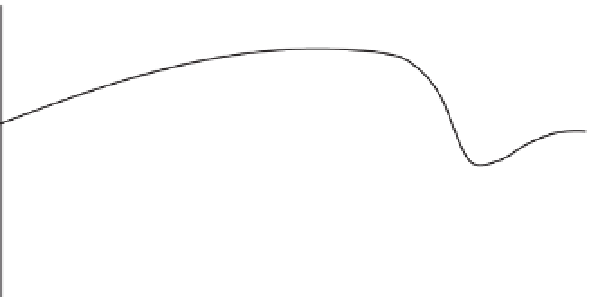Agriculture Reference
In-Depth Information
1.1
1.0
0.9
0.8
0.7
0.6
0.5
1
6
11
16
21
Age (weeks)
Fig. 16.5.
Ratios of methionine + cystine (Met+Cys) to lysine (Lys) and threonine (Thr) to Lys required by
growing pullets to maximize protein growth over time. Met+Cys:Lys
; and Thr:Lys
.
unusual, as the rate of maturing of feather pro-
tein has been reported to be 1.30 of body pro-
tein in growing pullets (Martin
et al
., 1994),
and 1.36 (Hancock
et al
., 1995) and 1.35
(Sakomura
et al
., 2005) in broilers. The simi-
larity in rate of maturing of these components
in this exercise is in spite of taking account of
feather loss during growth, which had no ef-
fect on the rate of maturing of feathers, which
remained at 0.023/day after correction.
There is no doubt that feathers are lost
during growth due mainly to damage and
moulting, so a correction for feather loss is
essential when the rate of feather growth is
estimated by serially sampling birds during
growth and measuring the weight of feathers
on the bird at each sampling, as was done in
this exercise. These losses may also be seen
as a measure of the requirement for the main-
tenance of feathers (Emmans, 1989). The rate
of loss used in this exercise (0.04 g/day) is
equivalent to a daily loss of 0.04% given the
mature weight of feather protein of
104
g
measured here. This is four times the rate
suggested by Emmans (1989) for broilers and
turkeys, but is based on the measurements
made by Silva (2012).
The contribution made by feathers to
the daily amino acid needs of the growing
pullet is substantial, especially for sulphur
deposited in feathers representing 0.50 of the
Met+Cys requirement of the pullet during
growth. However, because the concentration
of Thr in feather- and body protein is similar,
partitioning between these tissues when cal-
culating the Thr requirement during growth
is unnecessary.
The magnitude of the increase in amino
acid requirement during the sexual maturity
phase was related to the amino acid content
of the protein being deposited, thus Lys
showed the greatest increase during this
phase compared with the other amino acids.
Protein deposition in the ovary and oviduct
increased the overall requirements of Lys,
Thr and Met+Cys during growth by 65%,
60% and 37%, respectively, only during the
sexual maturity phase. This additional
amount of each of the three amino acids re-
quired during the development of the repro-
ductive organs is substantial and warrants
consideration when calculating the amino
acid requirements of the growing pullet.
The liver was the component that
showed the lowest rate of maturing (0.013/
day), being approximately half that of the
feather-free body protein. However, this in-
crease in liver protein growth occurs only
after the ovary and oviduct have reached
their mature state
(Fig. 16.2)
and when fea-
ther and body protein would also have
stopped growing, as no further body protein
growth occurs once the hen starts laying
(Fisher and Gous, 2008). The spurt in liver
protein growth after the 18th week of age in





